This collection of general barn
terms is offered in an on-going effort to educate barn
people in more precisely knowing the various construction
elements of vernacular barns and the various structural
components that builders incorporated into the buildings
that they erected and some of the tools that builders
used.
At the end of this general list of barn terms there
is found a list of terms that are normally associated
with Pennsylvania barns. Since Pennsylvania barns are
culturally very important and hundreds of thousands
of them still exist these terms are important to identify
various structural elements in them.
>>
Skip to Pennsylvania Barn Terms

ADZE - a wood
handled tool that has a cutting edge at a right angle
to the handle. Beams are often said to be adzed when
in fact they were most frequently broad-axed.
AISLE - a lengthwise area (parallel
to the roof peak) in a building that has spaces (often
three) that are created – often seen in Dutch-American
barns.
BAY – a cross wise or transverse
area in a barn that appears between adjacent timber
framing units or bents or a bent and an adjacent masonry
end wall.
BEAM – a fair sized horizontal
timber in a building’s framing system.
BENT –
a timber framing unit that consists of vertical posts,
horizontal beams and often diagonal braces that is erected
from a horizontal position to a final vertical resting
place. The units can either be longitudinally oriented
(side walls in English barns and Dutch-American barns)
or often transversely oriented (H-frames in Dutch-American
barns). See below:
|
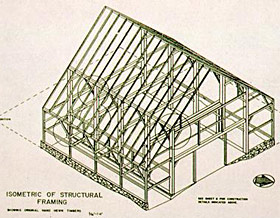
| BENT - An isometric
of structural framing of the four-bay Isaac
van Campen Dutch barn in Sussex County in
northwest NJ. |
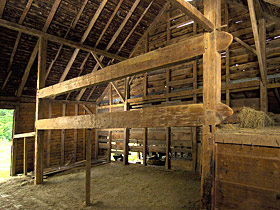
| BENT - An early nineteenth-century
side wall entry Dutch-American barn in northeast
Schoharie County, NY. Note the large double
ties or anchor-beams with extended tenons
in the one bent. (Photo courtesy of Geoffrey
Gross.) |
|
|
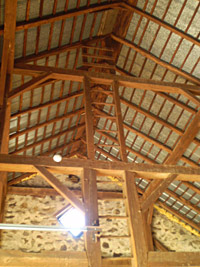
| BENT - A view of
the interior of circa 1850 stone to peak Kalmbach
Standard Pennsylvania barn in Macungie, Lehigh
County, Pennsylvania. Upper part of the bent
is seen with built-in ladder that flanks the
wagon bay. |
|
BOX FRAME
– a term usually assigned to English–based
construction where roof trusses are supported by a matrix
of beams and posts and wall plates. H-frames are not
seen.
BRACE - diagonal timber that appears
between a post and a beam and functions predominantly
in compression and very little in tension.
BROADAXE –
a well known wood handled cutting tool (with beveled
edge) for forming timbers where the handle is bent or
curved to prevent the hand from being cut on the timber
as it is being formed.
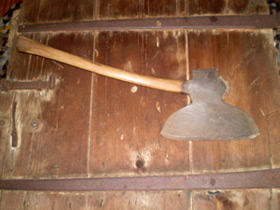
Broadaxes were a very
major wood cutting tool used by many pre 1875
house and barn builders. Note beveled cutting
edge and bent handle that are both classic features
of broadaxes. This tool was in the Eric Sloane
collection prior to 1975. |
|
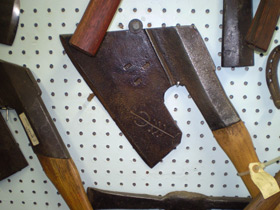
Goose-wing broadaxes have
been attributed to Germanic sources and untold
numbers have been found in the earliest settled
sections in southeast Pennsylvania. From collection
of William Phillips. |
CANTILEVERED BEAM
– a timber unsupported at one of its ends and
is very often found at the front wall area in Pennsylvania
fore-bay barns.
COLLAR BEAM – a horizontal beam
that unites two rafters in a rafter pair. Incorrect
term is collar tie.
COMMON PURLIN - a longitudinal timber
spaced at intervals that connects large or principal
rafters and carrying the roof sheathing.
COMMON RAFTER – a series of same
sized and pitched beams in the plane of a roof that
join in pairs and support roof sheathing.
EAVES – that edge of a roof that
over-sails a wall.
GABLE ROOF – the exterior end
wall that includes the roof peak and is above the eave
level and thus is triangular shaped – it conforms
to the upper roof edge.
GAMBREL ROOF – a roof that has
two roof slopes at each half side of the building where
the lower slopes are steeper than the upper slopes.
GIRT – a horizontal timber that
appears between adjacent wall posts between the bottom
sill and the top plate.
GUNSTOCK POST - a post that has a flared
out section at its top end to often receive a cross
tie and a longitudinal plate in the same area - also
called a jowled post.
HARDWOOD – one of two major botanical
wood classes that have porous wood – also called
deciduous woods such as elm, ask, oak and hickory among
many others.
H-FRAME – a term often reserved
for that distinctive bent in the middle aisle or nave
in Dutch-American three-aisle barns. Each bent consists
of a large horizontal overhead anchor-beam with two
vertical end posts and diagonal end braces. The anchor-beams
often have prominent extended tenons that define such
ethnic barns. H-frames are sometime called H-bents.
HEW – a shaped timber formed
from a log done by hand most often by a broad-axe.
JOINERY – the connections that
were created by timber framers by means of mortises
and tenons.
JOINT – the coming together of
timbers at a specific spot.
LONGITUDINAL – denotes a timber
that is oriented parallel to the roof peak or ridgeline
and the timber may be a full barn length one or a partial
one.
MARRIAGE
MARKS – are the marks incised into
the wood surfaces by carpenters at certain framing
joints. Such marks function as an accounting system
and often identical marks are seen on each timber
at the joint.
|
|
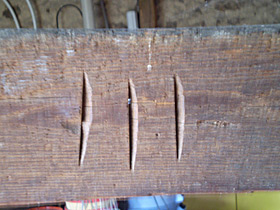
Marriage marks were used
by timber frame builders as a type of accounting
system for associating proper or “meant
to be joined” timbers to be put together.
These marks were most often formed by chisels. |
MORTISE
– the formed pocket or female place of a
timber joint where a projected tongue or tenon
or male part is inserted into. |
|
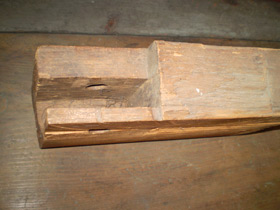
A mortise is a pocket
or chiseled-out area in timber for reception of
tenon of associated joined timber |
PENNSYLVANIA BARN – a particular
form of barn that originated in southeast Pennsylvania
that has a cantilevered front wall that extends for
various feet depending on the barn beyond the stable
wall. This barn type is always of two levels –
a basement and an upper level where various numbers
of bays were incorporated into the upper barn structure
where farm crops were stored and threshing of grains
occurred. A few classes
of Pennsylvania barns appear on the cultural landscape.
PLATE – a longitudinal or building
lengthwise timber that normally ties in all the tops
of bents or other framing units together. Plates are
usually associated with the words purlin or wall (rafter).
POST – (in general) a vertical
standing timber that supports other timbers or beams.
PRINCIPAL PURLIN – a longitudinal
timber that is part of a roof structure that connects
principal rafters and also carries common rafters.
PRINCIPAL RAFTER – part of a
roof frame that includes considerably larger sized rafters
that are interspersed with common rafters. These are
rafters seen in many earlier type English based barns
in New England and elsewhere and many pre 1830 Pennsylvania
fore-bay barns seen predominantly in southeast Pennsylvania.
PURLIN PLATE – a longitudinal
timber that often supports common rafters in many ethnic
barns. These plates are in turn supported by posts.
QUEENPOST – a vertical post that
appears as a pair that most often emanates from a tie
beam in an English barn or a tie from a bent that supports
a purlin plate. A three-bay barn for instance would
normally have a total of eight queen posts – four
per barn side.
RAFTER – an inclined roof timber
that supports roof sheathing above it. Rafters often
appear as single length timbers that run from roof peak
to wall plate.
SILL – a horizontal timber either
transversely set or longitudinally set that sits on
a foundation and connects posts in a frame.
SOFFIT – a very general term
that denotes the underside of any architectural element
or piece of wood.
SOFTWOOD – one of two major botanical
wood classes that have non-porous wood fibers –
also often called coniferous woods such as pine, fir,
spruce, hemlock, cypress and redwood among others.
SUMMER BEAM – often a building
length horizontal longitudinal timber of large size
that supports ceiling joists that in turn supports the
floor above it.
TENON – the projecting tongue
or male part that is inserted into a hollowed out area
or mortise as the female part of a timber union or joint.
TIE BEAM – a transverse timber
usually found at the top of a framing unit or bent or
a few feet below the top of the bent.
TRUNNEL – a wood peg or pin that
unites a mortise and tenon together in a timber joint.
TRUSS – a complex of timbers
that forms a rigid support structure and often associated
with roof supports.
VERNACULAR – a term applied to
local manufacture, style and materials due to influences
of culture and climate and other factors.
WANE – the natural curve (last
annual growth ring) of a timber that appears just under
the bark of a tree.
WIND BRACE – a brace that lies
in the plane of a roof.

BAY – The
space or area between adjacent framing units or bents.
Thus, in a frame barn with four bents there are three
bays. A barn with five bents has four bays, etc. In
stone barns the so-called end bay is the area between
the last bent and the adjacent stone gable or end wall.
Therefore, two end bays appear in these barns.
BENT – A major transverse framing
unit on the second floor level that consists of partial
barn width tie beams, vertical side wall posts, mid-point
posts, braces of varying lengths and, often, built-in
ladders. These bents were assembled on the barn floor
or ground and then raised from a horizontal position
to a vertical position by the efforts of a number of
men using pike poles. At the top of bents, full barn
width upper tie beams appear that are not actually parts
of the bents as these ties were positioned after the
bents were raised. This is referred to as normal
assembly; whereas, when upper ties in certain
barns were dropped below the level of the posts, the
term is called reverse assembly.
BRACE – These diagonal members
are either relatively short or quite long. When they
are short, these beams connect partial tie beams to
either the wall posts or the centered posts of the bents.
They prevent the bents from lateral racking. Braces
can also appear in other areas of the barn such as in
the plane of the roof where they are known as wind braces.
They can also connect purlin plates to queen posts.
When they are long, they appear from the floor sill
to the partial tie beam. These braces are often considered
to be Germanic in nature. In Pennsylvania barns, braces
are most often pegged at each end.
BUlLT-IN LADDER – These ladders
are original elements and are most often centered on
the bents that are adjacent to the wagon bays. Thus,
Pennsylvania barns very often have at least two built-in
ladders and three ladders very often appear in four-bay
barns. They often have rungs (of oak) or the ladders
can assume other forms such as cut-out areas in horizontal
boards that function as rungs. Occasionally the ladders
extend to the roof. Quite often they extend to the straining
beam when vertical queen posts appear.
FOREBAY – That part of a Pennsylvania
barn on the second floor which is located toward the
barn front wall that cantilevers over the stable wall
of the basement. The fore-bay is also called an overshoot.
Recall from above that the Pennsylvania barn is defined
as a two-level banked barn with a fore-bay at the front
wall. Other barn types, such as one-level ground barns,
occasionally have fore-bays.
GABLE – That wall at the end
of the barn that includes the triangular section above
the eaves level that extends to the roof peak. Gable
walls are opposed to side or eave walls. Thus four sided
barns have two gable walls and between them are two
side walls.
GRANARY – Very often located
in the fore-bay side of a Pennsylvania barn and extend
into the area behind the area of the fore-bay. The one
side or wall of the granary is continuous with the mow-stead
wall that flanks the threshing floor. The front wall
of the granary is actually part of the front wall of
the fore-bay. The other wall that is opposite the mow-stead
wall is the end wall of the barn itself. Both the back
wall and ceiling of the granary are made of boards.
Granaries are broken up into individual grain-bin compartments
for storage of grain. At the front of the granary is
a passageway for access to the bins. Ceilings are about
6 to 7 feet high. Above the granaries farm crops were
stored.
JOISTS – Transverse ceiling timbers
in basements that extend from the rear wall over the
stable-wall and out to the front fore-bay wall. Most
often joists are supported by and are positioned over
summer beam(s). Joists are most often of oak and can
attain widths of 10 to as much as 18 inches. Joists
along their interior lengths are often left in the round
at their sides. In contrast they are hewn square beyond
the front of the stable walls apparently for aesthetic
reasons.
LONGITUDINAL – This is an orientation
of a barn timber that is parallel to the ridgeline.
Full barn length longitudinal timbers are purlin plates,
wall plates, summer beams or front fore-bay wall sills.
Other longitudinal timbers that do not run the full
barn length are girts or horizontal timbers at the front
wall in Standard barns. Longitudinal timbers are placed
at ninety degrees to placement of transverse (see below)
timbers.
LOOPHOLES – One of the major
means of ventilating the interiors of certain stone
barns in eastern Pennsylvania and perhaps elsewhere.
Loopholes appear in two different forms – as vertical
slits or balistratus (2 to 3 feet in height) or as brick
lined holes (openings 9 to 10 inches in diameter). The
slits are found in barns in a number of counties in
southeast Pennsylvania while the holes are seen in barns
within only about a dozen miles or less on either side
of the Delaware River. Usually, several rows of loopholes
of either type are seen on gable walls and most often
in two rows on the rear walls of stone barns. Barns
with vertical ventilator slits preceded barns with brick
lined loopholes by a few decades. The earliest known
barn with slits appears in a dated 1761 ground barn.
Loopholes outlined in brick most often stand rigidly
as first made and exist as finely crafted examples of
early type brick masonry that have survived up to 175
years on certain barns in Northampton and Bucks County.
Standard barns and perhaps even a Switzer barn or two
possess such loopholes. It appears that these loopholes
in most cases did not appear on barns until about 1825
or even 1830 up to about 1850 or so and perhaps beyond.
Other barns have louvered or slatted windows that may
have preceded brick lined loop-holed barns by about
a decade.
MOWSTEAD
WALL – Mow-stead walls are part
of the bents that flank wagon bays in barns, often
appearing five to six feet and sometimes more
above the wagon floor. They consist most often
of horizontal boards often of pine or of oak in
certain pre-1810 or 1820 barns that are secured
by wrought, transitional or cut type nails. Such
nails can quite often be good general indicators
of construction ages of barns. These boards are
nailed to partial tie beams and bent posts that
are often notched to receive the ends of the boards. |
|
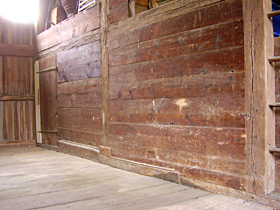
Mow-stead walls are very
commonly found in upper floor levels in Pennsylvania
barns. Here is the mow-stead wall in the dated
1835 Marcks Standard stone to the peak bank barn
in Lower Macungie, Lehigh County, Pennsylvania.
|
PElLER ECK – This is the German
dialect word for pier corner. These are ell-shaped formations,
always of stone, most often at the front corners of
Standard barns and certain Switzers at the basement
level and above in all stone barns. They were included
in the fabric of the barn for extra support of the stone
gable walls.
PRINCIPAL RAFTER SYSTEMS – Rafter
systems in barns that have much larger rafters that
are in line with bents and in end bays than the so-called
common rafters that appear between the principal rafters.
Most often in the southeast counties of Pennsylvania,
these large rafters do not normally appear in barns
built until about 1790 and are quite rare in barns after
about 1830 or 1840. (See Purlin Plate and Rafter)
PURLIN PLATE – Barn-length or
longitudinal timber that extend from one gable (end)
wall to the opposite gable wall. They appear in pairs
– one per roof slope. Purlin plates support rafters.
They are quite often spliced or come in two or three
sections or lengths. The points where plate sections
meet the splicing areas are referred to as scarf
joints. Barns that feature Principal Rafter
Systems have purlin plates that are decidedly different
than in those that are seen in barns that have Common
Rafter Systems. These purlin plates instead of being
in one long single piece or spliced timber are sectioned
and quite often staggered. That is,
they appear in single length sections or timbers between
adjacent Principal Rafters. They are staggered in that
they attach to the sides of the Principal Rafters at
different points along the lengths of these rafters.
In addition, barns of large size with Principal Rafters
very often have a double level or tiered system of purlin
plates ostensibly for greater support.
QUEEN
POST – A vertical or angled timber
(depending on the barn) that extends most often
from an upper tie beam of a bent or structural
framing unit to the soffit or undersurface of
the purlin plate. Thus, the queen post supports
the purlin plate. In certain early German barns
with particular roofing systems there are no queen
posts. In certain other early German barns, there
are queen-like posts. When posts are angled the
term canted is applied. Canted queen posts are
often utilized in later barns; that is, after
about 1840, but can appear before that time. |
|
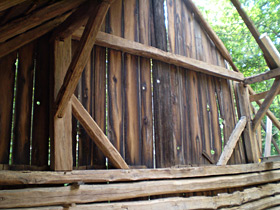
Vertical queen posts are
timbers of relatively short length that supported
mid-length roof support timbers called purlin
plates. In certain other barns angled posts are
called canted queen posts. |
RAFTER – These are the major
structural members of the roof, often of oak, that appear
just below the outermost roof covering that support
the covering. Rafters virtually always come in pairs
and in almost all pre-Civil War barns and fairly often
in post-Civil War barns are pegged at the roof peak.
Rafters at their bottoms join to the wall plates that
sit atop the side walls that are of frame, stone or
brick construction. Rafters that are of the same basic
size in a given barn are referred to as Common
Rafter Systems.
Many early era barns, most especially in the Saucon
Valley in Northampton County in the 1790 to 1840 time
frame, have English based Principal Rafter Systems.
Such barn roofs consist of (depending on the barn) two
to five Principal Rafter pairs where each truss is composed
of two large sized and paired rafters. Principal Rafter
pairs are either in line with the framing units or bents
or they appear about mid-way in end bays in certain
barns. They alternate with considerably smaller sized
common rafters. Such rafter systems of about 140 barns
of various ages and types have been identified by EBC.
SIDE WALL – The side or eave
wall is the wall that appears between the gable walls.
In the great majority of Pennsylvania barns the main
wagon doors appear on the rear side wall. The front
fore-bay wall should be considered a side wall.
SILL – This timber appears at
the edge of any floor that appears in a fore-bay barn
(and in other barns). Individual sills acting in concert
constitute a sill system. They appear along the edges
of threshing bays and wagon bays. They also appear at
the bottom of the floor at the front wall of the fore-bay.
SPRIGGEL BAR – A horizontal bar
of wood at the horse entry doors on the stable wall.
These are set into the wide wooden door jambs about
halfway up the door opening, and slide freely into a
horizontal pocket in the stone or into long wood boxes
built into the stone wall at the one side. These bars
kept the horses contained in the stable areas. Spriggel
bars are more commonly found in barns built before
about 1840 but exceptions exist. Rarely two bars are
seen per door opening.
STABLE WALL – The stable wall
or stahlwand at the basement level in Pennsylvania
barns often of stone and sometimes of brick or even
wood is set back from the front edge of the end wall
by four to as much as ten or more feet. It contains
several animal doors and one or two feed-entry doors.
Very often these doors are halved, with a top and bottom.
STRAINING BEAM OR QUEEN POST TIE BEAM –
These transverse beams stretch from one queen post to
the adjacent queen post above the bent with which it
is in line. They were often included in barns constructed
before about 1860 and less often after that time. In
many barns these ties were removed when metal hay tracks
at the roof peak were installed after the Civil War.
These tie beams very rarely or never appear between
canted queen posts.
SUMMER BEAM – This is the barn-length
longitudinal ceiling beam – gable wall to gable
wall – in the basement that forms the main support
of the second or loft floor above. Actually, joists
support the floor above, but the summer beam in turn
supports the joists that appear above the summer. They
are often spliced in one or two spots. Summer beams
are often large-sized and very often oak. A fair to
good number of barns have two summer beams. Rarely do
barns have three summer beams. And one very large circa
1840 barn east of State College remarkably has five
summer beams.
TRANSVERSE - This is an orientation
of a timber positioned in a barn that is perpendicular
to the roof ridgeline - or side wall to side wall. Full
barn width transverse timbers are upper tie beams and
basement level ceiling joists. Another type of transverse
timber that does not run the full barn width is a partial
tie beam that appears in bents a few feet below the
upper tie beam.
UPPER TIE BEAM – This is the
transverse beam at the top of a bent that spans nearly
the entire width of the barn and appears at the top
of the bent or more rarely that is seen dropped one
to two feet below the tops of the posts. It is almost
always in line with the wall plate. Upper tie beams
are usually associated with early English barns in New
England and they tie the longitudinal side wall bents
together. In Pennsylvania these beams rest on side wall
posts that appear on frame barns and may or may not
rest on posts in stone barns. They are placed into position
after the bent is raised into its vertical place. This
type of beam is found in Pennsylvania fore-bay barns
until the Civil War and occasionally beyond.
UPPER PARTIAL TIE BEAM – These
beams are sometimes called scaffolding beams. They often
appear in bents of Pennsylvania fore-bay barns and are
seen a few feet below the upper tie and stretch between
a side wall post and a centered post.
WALL POST – These are major vertical
timbers that are part of the front walls in stone Standard
barns and on both front, rear and gable walls in frame
Standard barns. Posts appear most often in bents at
both the front and rear side walls.
|
|